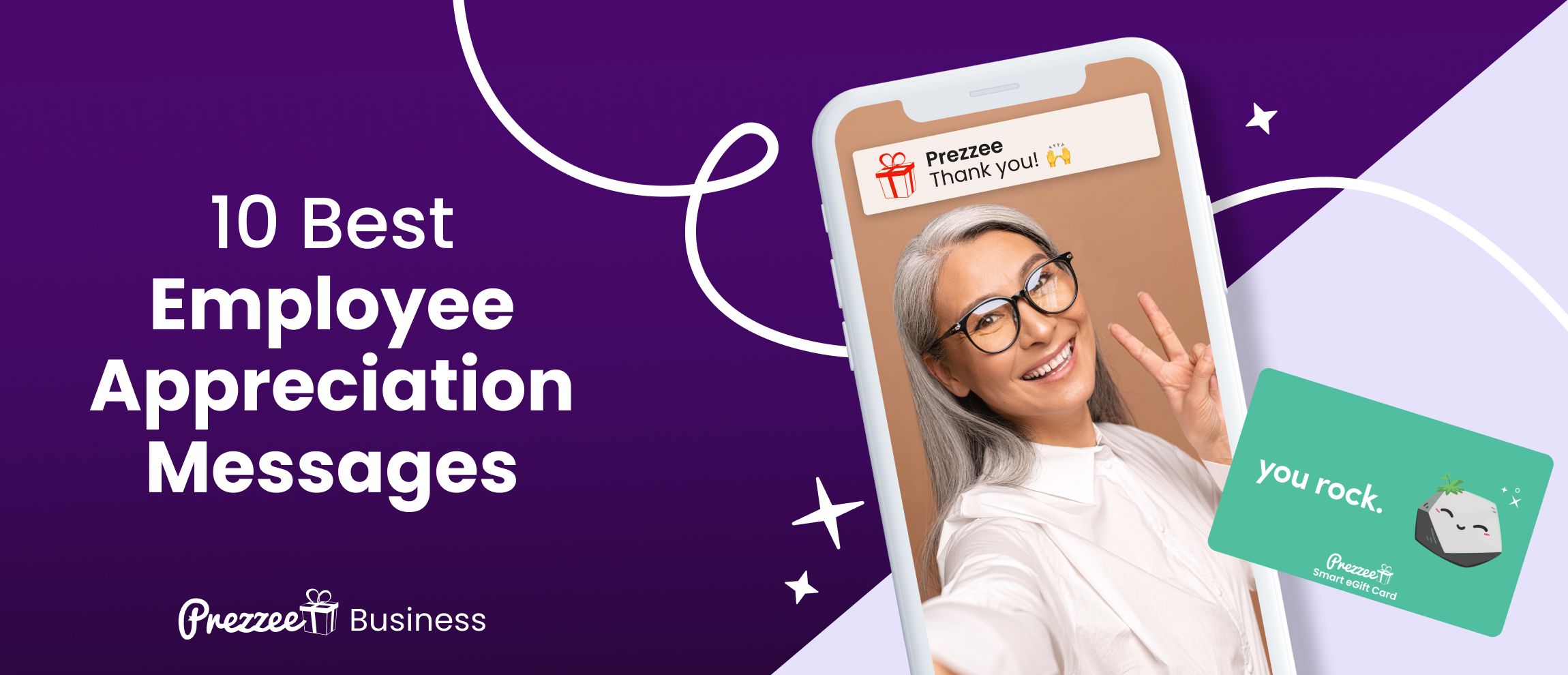How To Use Marketing Incentives to Increase Sales



How To Use Marketing Incentives to Increase Sales
We all want a marketing strategy that helps the culture of our business thrive. By offering incentives for hard work, you can motivate your teams to drive sales enthusiastically.
At the same time, you can create loyal customers by offering tangible rewards programs that incentivize them to keep coming back. With the right incentive marketing campaigns, you can see employee engagement soar while customer retention stays strong.
There are a variety of effective incentives that boost workflow. The key is finding the one that fits your workplace.
Here’s Prezzee’s guide on the marketing incentives you can use to increase sales:
Using Incentives to Build Customer Loyalty
With the right incentive marketing strategy, you can build customer loyalty and spread brand awareness, picking up new customers along the way.
Loyalty programs can encourage brand recognition, making your business the go-to place for enrolled customers to save money on the things they need. Meanwhile, referral programs help to spread the word and bring in new faces.
Let’s take a look at some incentive programs you can try:
Loyalty Programs Reward Return Engagement
By implementing a loyalty program, you can incentivize customer loyalty by offering exclusive rewards for returning members. High-quality, practical perks and benefits give clients an opportunity to save money by sticking with you.
Some of these perks might be:
- Discounts/coupons that add up with more purchases
- Exclusive deals for holidays and seasonal sales (think Black Friday and Cyber Monday)
- A free item after hitting a certain purchase price threshold
- Early access to new products
- Sweepstakes where customers can win free items
The Necessity of Loyalty Programs
REPLACE WITH IMAGE
As inflation increases and we recover from the pandemic, Forbes reported that customer acquisition and retention are determined by perceived value and savings. More people are looking to remain loyal to brands that use discounts, rewards systems, and other perks to repay them over time with a better value on products or services. This remains true even when the costs of those products rise.
Savings matter more to today’s customers than before. A thoughtful brand loyalty incentive program is a convenient way for them to save on brands they already love. These make it easier and more affordable for customers to feel comfortable making purchases with your brand.
Referral Programs for Customer Acquisition
Referral programs are some of the best incentive strategies to bring in new customers. This type of incentive rewards existing customers for referring people to your business.
The best way to use this type of incentive is to reward both the existing customer and the new customer they brought in. This way, the referred customer is also incentivized to go through and give your business a try.
Oftentimes, businesses will make it so that the perks both types of customers earn are conditional on whether or not the referred customer tries out the business or remains loyal over time.
Your new customer will feel like they got an exclusive deal by going with you. Plus, hearing about your company through word-of-mouth makes a trustworthy impression. Ninety-two percent of people trust recommendations from their social circle more than traditional advertising campaigns, factoring this vote of confidence into purchase decisions.
Referral Programs for Lead Generation
To give you a better idea of how some of these programs work, review these referral marketing strategies:
- Subscription-model businesses use referral programs that reward the new and existing customers per each month they remain subscribed. Each consecutive month, the rewards get increasingly better. These rewards may be increasingly better discounts, better free items every month, more membership loyalty points, and so on.
- Some businesses will offer customers reward points for referring their friends. These points can be spent on products or digital gift cards in the store or on supported brands. Subscription model businesses have been known to offer free subscription time as well. For example, if a user buys an annual plan instead of month-to-month payments, they’ll get a 13th month free.
- Online stores will reward their members with free items when they refer someone to make an account on the website. The person who makes the account will get the free item or a promo code/discount as well.
- Some retailers will give discounts or BOGO sales for those who bring in a new customer. Typically, this program involves signing up for the store’s membership to earn the initial discount.
Reaching Your Target Audience
By implementing a referral program into your marketing efforts, you can reach your target audience through your very own customers.
Referral programs are probably one of the best incentives for spreading brand awareness.
Additionally, they can boost customer retention as well. Some surveys have indicated that customer retention is higher for referred customers, along with a higher lifetime value.
The case study from Wharton Business School relays an interesting note: Referred customers were about 25% more profitable than those who found the brand organically. This number tends to decrease after the first year but is still impressive when considering the lifetime value. The lifetime value of a referred customer is 16% higher than traditional shoppers.
Incentive Marketing to Spread Brand Awareness on Social Media
Another kind of referral incentive program is through social media. With this type of incentive marketing, you reward followers for sharing your business with their followers and bringing in potential customers. One of the most common types of incentive marketing done on social media is the giveaway.
Let’s break this marketing strategy down:
- On social media, you announce that you're doing a giveaway. This can be a product on your website, free rewards points, a big discount, or a customizable eGift card.
- In order to qualify for the giveaway, followers have to like the post, share it with their followers, and follow your account. Sharing can take the form of reposting, linking a post to a story, or tagging a certain number of friends in the comments.
- You choose the winner randomly out of those who liked the post, making sure they followed all the requirements. Some randomizer tools include Google’s random number generator, Wheel of Names, or apps like Pickster.
This increased online engagement gives you a meaningful metrics boost. As their followers discover your giveaway, they’ll have to follow you if they want to win. In the process, you spread brand awareness to those most likely to be interested.
Rewards Programs for Retailers
Rewards programs are a popular option for retailers. With this type of incentive, you repay customers with reward points whenever they make a purchase.
Customers are then incentivized to keep coming back and making more purchases, so they can save up reward points to use in the future. These reward points can function as discounts, taking a certain percentage off a product’s price, depending on the number of points.
In other cases, you might put reward point price tags on certain items or exclusive early access passes. This is a great way to show gratitude to your customer base with free items for their continued support.
Incentive Strategies That Boost Productivity
REPLACE WITH IMAGE
While incentive marketing is a great way to increase sales, there are ways to use marketing incentives within your workplace. These incentives boost the mood of the workplace, encourage employee retention, and help productivity soar.
You can say thank you in a meaningful way for all your employee’s hard work and reward them for going above and beyond. Try some productivity incentives like these:
- A digital gift card for the highest performing employee to a restaurant of their choice.
- Free coffee or tea for coming to the office early or for being the first in a Zoom meeting.
- A reserved parking spot for employees of the month.
- A special shout-out on Slack, Workday, or your messaging service of choice.
Employees feel motivated to be more productive when they have a meaningful incentive to do so, as some studies have pointed out. When employees feel like their work is recognized and appreciated, the mood of the workplace improves, increasing energy and concentration.
Sales Incentives to Raise Metrics
By using sales incentives, we can set goals for employees that encourage innovation and ambition. Sales teams want to put in the extra effort to raise your bottom line, especially if it helps them earn recognition within the company.
Oftentimes, the pressure of the workplace can make company success difficult. Employee turnover gets higher when companies expect high performance but don’t reward it in any real tangible way.
Some sales incentives can also create friendly competition that motivates employees to go above and beyond. This might be something like:
- An employee-of-the-month award
- An incentive gift for reaching the top of a sales leaderboard
- A high performer of the week spotlight, with a reward such as paid time off
A little bit of friendly competition can improve spirits, encourage innovation, and fuel productivity.
Employee Appreciation Motivates Team Members
When employee appreciation is a company-wide, top-down priority, team members see that their work benefits the company and are rewarded accordingly.
Employees will remember that feeling, increasingly motivated to outperform themselves. Incentives can be a great way to show our appreciation for a certain member of our team in a personal way that encourages their interests.
Your employees bring a lot to the table — including their professional network. Get creative with your internal incentives with rewards for employee colleague referrals. New hires that come from referrals from active employees are more likely to perform better and stay longer, saving businesses tens of thousands of dollars a year.
After a new hire has completed a set number of days (for example the 90-day mark), reward the referring team member with a digital gift card that highlights their personal interests for a thoughtful touch. This might be an eGift card to a sports store or gym or an eGift card toward an outdoor adventure.
Driving Sales with Team Incentives
Make sure to celebrate top performers with the rest of your team. When an employee makes a big sale, try inviting the whole team to celebrate that accomplishment.
For remote employees, give them a special shout-out on your workplace messenger or mention them during a Zoom or Google Meet meeting. You can reward the whole team with fun events like Zoom gaming tournaments, virtual happy hours, or workplace trivia, giving them a break during the regular work day.
When we emphasize the team and celebrate individual accomplishment as something that comes thanks to support from others, we can uplift our employees to become top performers. Instead of one employee outshining the others, the whole sales team is inspired.
You may have many top performers in your workplace team who are only missing the motivation and support they need to really excel.
Prezzee Makes Marketing Incentives Easy
REPLACE WITH IMAGE
We hope you’ve enjoyed this guide and learned a lot of new ways to use marketing incentives in order to drive sales. At Prezzee, we are passionate about helping workplaces thrive with positive reinforcement.
Whether you’re looking for a holiday gift, a prize for a high performer, or a reward for the winner of a sweepstakes, Prezzee has hundreds of eGift cards for any occasion.
Sources:
Creating Loyalty in Volatile Times | PwC
Brand Loyalty Amid Inflation: How To Retain Your Customers | Forbes
Why Word of Mouth Beats Advertising | Business News Daily
Maximizing the Benefits of Customer Referrals (Van den Bulte) | Baylor University



